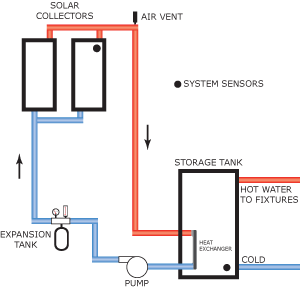How Solar Energy Heats Your Domestic Hot Water
 The solar water heating system is fully automatic, requiring no routine
maintenance to provide your household with free hot water each sunny day.
Your present water heating system is retained and used as the backup in the
event of prolonged cloudy weather.
The solar water heating system is fully automatic, requiring no routine
maintenance to provide your household with free hot water each sunny day.
Your present water heating system is retained and used as the backup in the
event of prolonged cloudy weather.
Presently in your home, cold city or well water enters your water heating equipment and is raised to temperatures of about 130 degrees. Since the incoming water is around 55 degrees, a considerable amount of energy is required to raise the water temperature to the desired comfort level.
With a solar domestic water heating system, the incoming water goes to the solar storage tank first, where it is pre-heated prior to flowing into your existing water heating equipment. Temperatures in the solar storage tank can be as high as 120 degrees in the winter and 150 degrees in the summer. Each time that you open a faucet in the house, warm or hot water flows into your present water heater, substantially reducing the cost for heating the hot water.
The solar water heating system consists of roof mounted solar collector panels, a solar storage tank with heat exchanger, a circulating pump, and control unit. The temperature of the solar panels is always being monitored by the control unit and compared to the temperature of the lower portion of the solar storage tank. Whenever the solar panels are warmer than the storage tank, the circulating pump is turned on and circulates a non-toxic heat transfer fluid through the solar panels. This fluid is heated while flowing through the panels and is returned to the heat exchanger located in the solar storage tank where the heat is transferred to the water in the tank. When the solar panels can no longer raise the temperature of the storage tank due to sky conditions (clouds, night-time or low sun angle) the system controller will automatically turn of the circulating pump. The next day, or when sufficient solar energy returns the process repeats itself.













